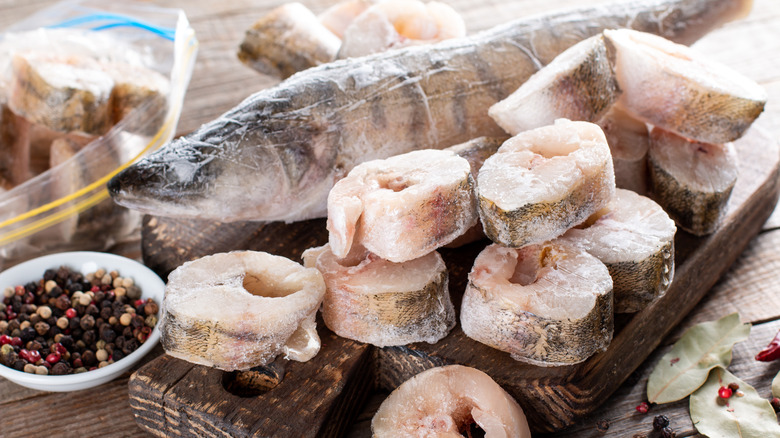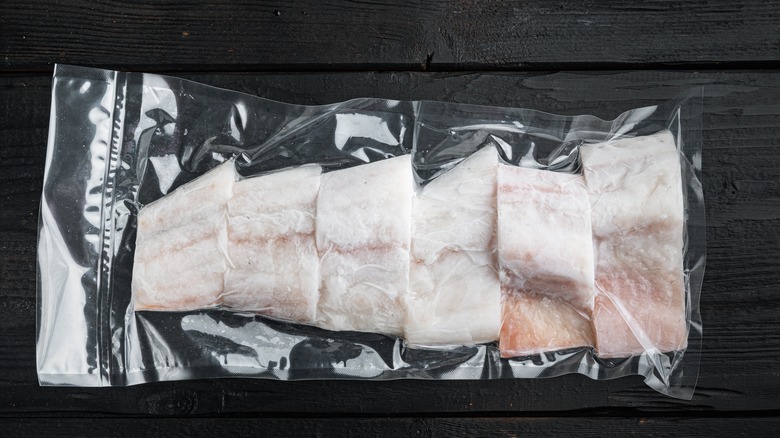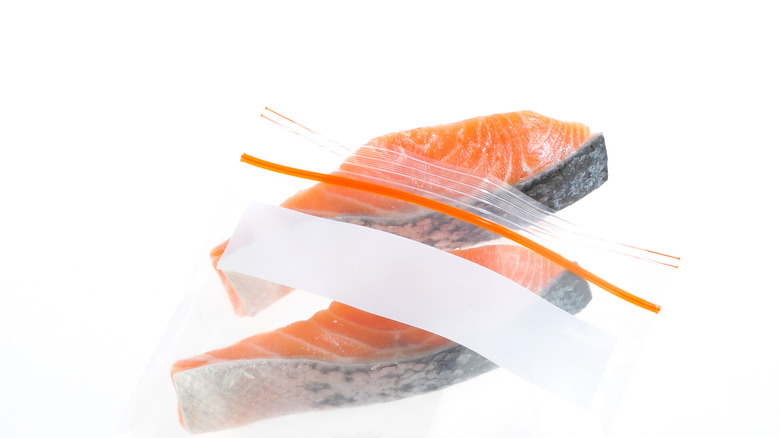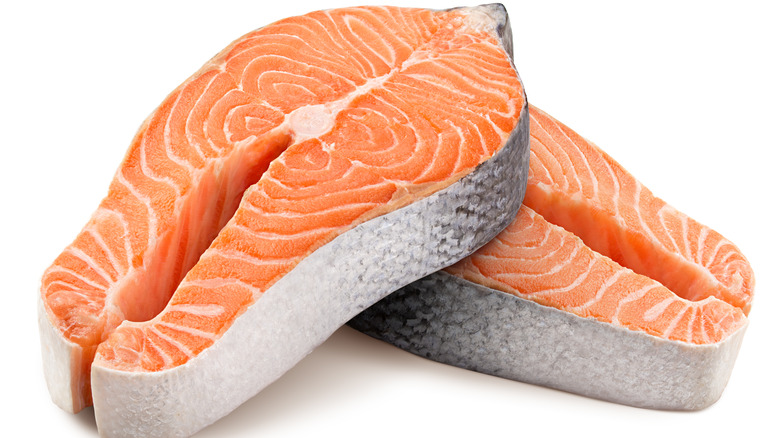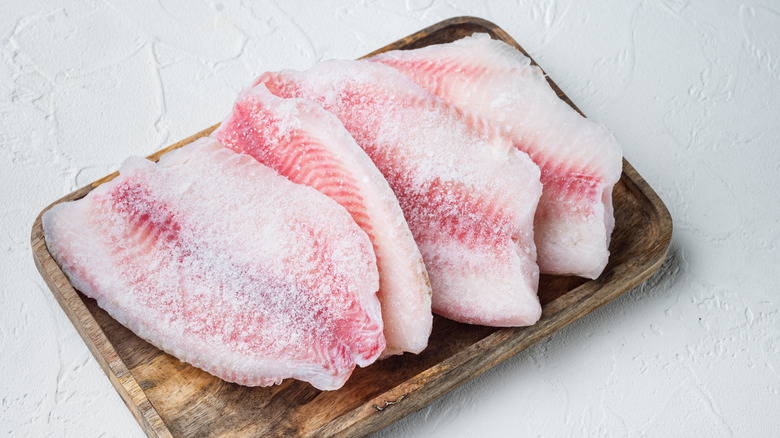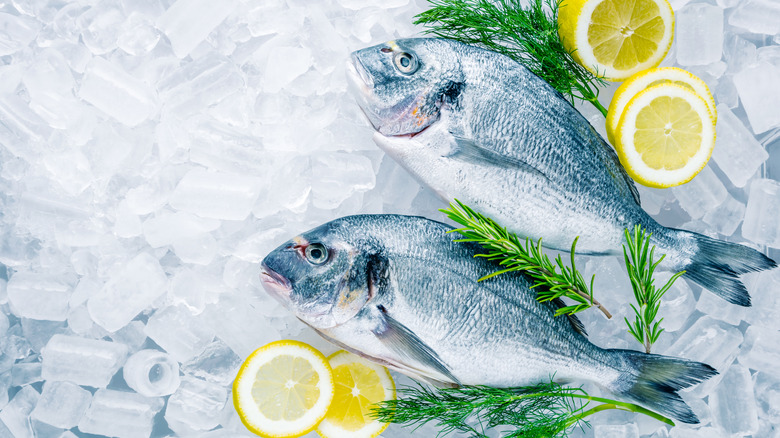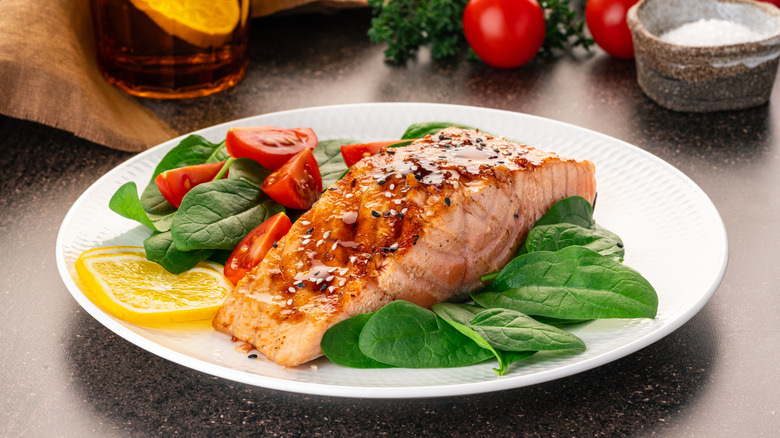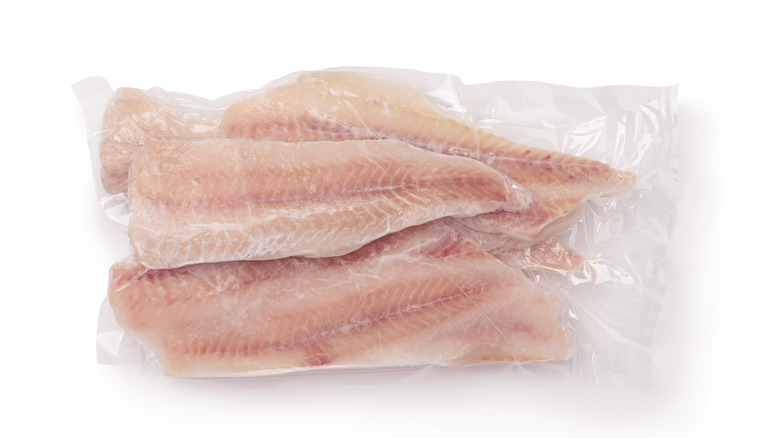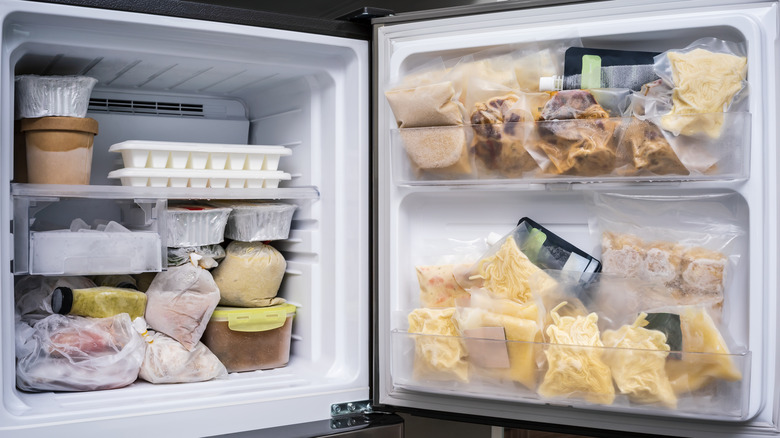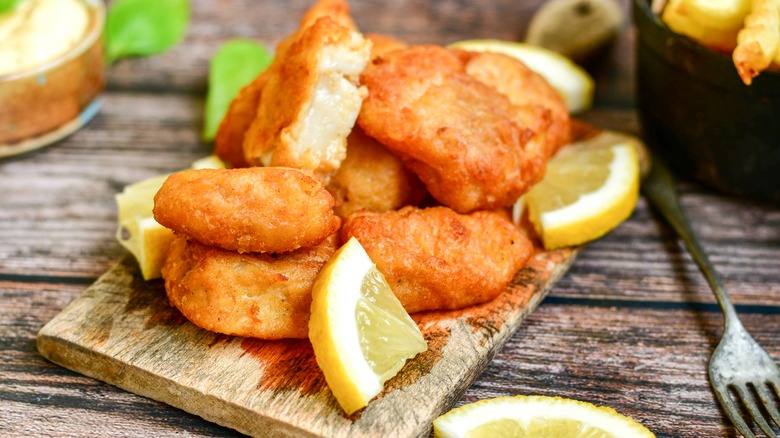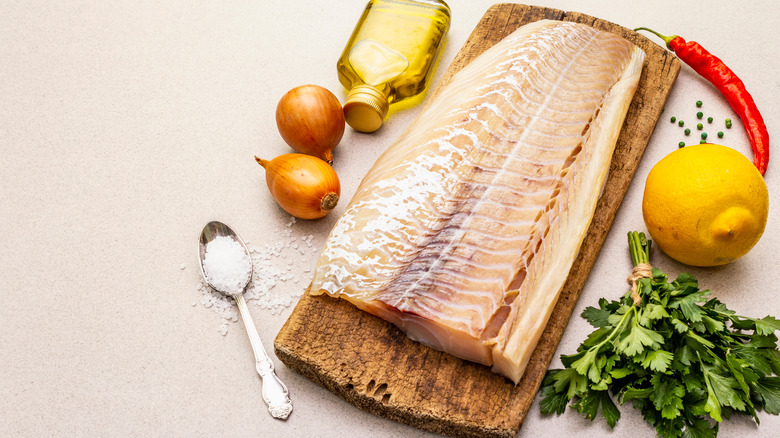Mistakes People Always Make When Freezing Fish
Whether you caught it fresh or bought it fresh, freezing fish means you'll always have some on hand for a quick meal. But mistakes made while doing so can easily reduce the quality of your catch of the day. Fish can be delicate, and the flesh is highly susceptible to changes in texture and flavor when you don't get the freezing conditions just right. If there is too much water or not enough water, you risk a soggy, or tough and dry, finished product when you take your catch out to cook it (via University of Alaska Fairbanks).
Not wrapping it properly before storing it, freezing it too long, temperature fluctuations in the freezer, and freezing cooked fish when it's still warm, among many other things, can all ruin a perfectly delicious filet. Avoid these mistakes to make your fish last longer in the freezer and taste just as fresh on day 90 as it did on day one.
Mistake: not wrapping it properly
If your fish isn't wrapped properly when you pop it in the freezer, you risk oxidation and desiccation, or dryness (via University of Alaska Fairbanks). Oxidation of fats is particularly likely with fish such as trout, salmon, and whitefish, which are fattier. Oxidated fats can cause unwanted flavor changes and moisture loss that results in a rough, dry texture. Freezer burn, in which ice crystals form on the exterior of the fish, is a result of improper packaging and can also cause moisture loss and flavor changes (via Whirlpool).
To prevent these changes, you need to wrap the fish tightly and keep air out of the package as much as possible. Vacuum-sealing fish is the best way to do this. A vacuum-sealing device sucks out all the air and, when used with oxygen-blocking film bags, is a highly effective method for wrapping fish for freezing (via University of Alaska Fairbanks).
If you don't have a vacuum sealer, plastic wrap is the second-best option. Make sure the film adheres tightly to the surface of the flesh, and double-wrap it for the best results. Finally, wrap it again with aluminum foil or butcher paper to provide another layer of protection.
Mistake: using freezer bags incorrectly
Freezer bags are another serviceable option for wrapping fish for freezing, although not as effective as vacuum-sealing or plastic wrap. Both zip-locked and twist tie bags work equally well. The problem is that many people don't use freezer bags correctly. It's crucial to empty as much air as possible from the freezer bag. Air is a major factor in fish spoilage (via University of Alaska Fairbanks).
If you decide to use freezer bags, the most effective strategy has two steps: Place the fish in the freezer bag and get as much air out as possible before sealing it and placing it in the freezer. Wait a few days and then remove the fish from the freezer, open the bag, and add a little cold water. Move the water around in the bag to get rid of any pockets of air, close the bag, and put it back in the freezer. You only need a minimal amount of water, and you should not add it to the bag before freezing because the fish will absorb the water and be susceptible to changes in flavor and texture.
It's important to note that freezer bags and storage bags are not the same thing and cannot be used interchangeably. Freezer bags are thicker and more durable and made specifically for long-term storage (via USA Today). The thickness of freezer bags enables them to protect foods from freezer burn.
Mistake: not glazing fresh fish
Glazing isn't a mandatory step, and if you're not doing it — or don't want to — it's not make or break. However, it can make a big difference in storing fresh fish. Glazing is often used by commercial fish processors to prevent freezer burn when the fish is going to be stored for a long time (via University of Alaska Fairbanks). It involves coating the fish with a thin, protective layer of ice.
To do it, first properly wrap and freeze the fish. After a few days, when it's completely frozen, remove it from the freezer and dip it in or spray it with ice-cold water. Pure Food Fish Market recommends lightly salting the water. Lay the fish on a baking sheet lined with parchment paper and pop it back in the freezer. Repeat this process again until you have a glaze that is about ¼ inch thick. Then wrap it up again. This method can protect frozen fish for up to six months.
Note that the ice glaze is delicate and easily broken, so handle the fish with care. According to University of Alaska Fairbanks, the ice glaze can evaporate in the freezer, and the process should be repeated every few months.
Mistake: keeping fish in the freezer too long
You might think that frozen foods have an infinite lifespan. Safety-wise, that's true. But flavor and texture are another story. The longest you want to keep fish frozen from fresh is about eight months (via the USDA), and that's assuming you've wrapped it really well or glazed it first. If it's cooked before you freeze it, then you should consume it within three months.
Different types of fish freeze better than others, and their quality may hold up longer than other types in the freezer. Per fishmongers Jenkins & Son, fatty fish like trout and salmon are heartier in the freezer than leaner white fish like sole.
Perhaps you can't remember when you originally put the fish in the freezer? Labeling your catch before putting it in the freezer can help you keep track. Use freezer tape or labels made specially for freezing. On the label, include the type of fish, the date, any additional ingredients that may be in the package, the number of servings (if more than one), and any other helpful identifying information (via the National Center for Home Food Preservation).
Labeling takes just minutes, and it can save you a lot of time and energy when you're rummaging through your freezer for dinner or trying to take stock of what you have on hand. It can also help you avoid food waste and save money.
Mistake: freezing fish too slowly
When fish isn't frozen quickly enough, its proteins are negatively affected, resulting in a change in texture. This is due to a process triggered by freezing called denaturation, in which the molecular structure of proteins is altered. According to the Food and Agriculture Organization of the United Nations, the highest denaturation activity happens between 30.2 and 28.4 degrees Fahrenheit. But as the temperature continues to drop, so does denaturation activity. Therefore, fish that can be brought through this "danger" zone faster will experience less damage to the proteins and have a better texture when thawed for cooking.
Oxidation of fats in fish can also be slowed down by quick freezing. Fat oxidation is the major reason for flavor and odor alterations in fish — whether they're fatty or lean.
Flash-freezing is widely used in commercial fisheries, and it requires specialized equipment that most home cooks and recreational fisherpeople don't have (via CRS Mobile Cold Storage). That doesn't mean you can't minimize the time your fresh catch spends in the danger zone, though. One method is to temporarily lower the temperature in your freezer. Once your fish is frozen, you can turn the temperature back up. Yotur freezer might also have a fast-freeze function built in. If so, turn this on a couple of hours before you're going to freeze your fish (via CookUK).
Mistake: freezing cooked fish while it's still warm
Cooking up fish dishes in larger batches and storing leftovers in the freezer is a great way to plan ahead and have quick dinners on the table on busy weeknights. However, you might be making a common mistake when freezing your cooked catch: putting it in the freezer while still hot. Especially if you're cooking a large piece of fish, putting it in the freezer when it's too warm can cause the temperature inside the freezer to rise (via Michigan State University). This can cause temperature fluctuations that can lead to thawing of your other frozen foods, which can affect their quality. It can also open the door for the growth of pathogens and bacteria that could cause foodborne illness.
The safe way to freeze cooked fish is to portion it and wrap each piece separately before storage. Follow a two-phase cooling process to bring the internal temperature down gradually: Food should be cooled to 70 degrees Fahrenheit within two hours and then to 41 degrees or lower over the next four hours. In other words, after your fish has cooled to room temperature, you can pop it in the fridge while you're watching a movie and then place it in the freezer before bed.
Mistake: not freezing fish in portions
It might seem easier to place the whole fresh fish in the freezer and worry about portioning it out later. Huge mistake. There are myriad reasons why forethought is important in this case. First of all, freezer space. In most homes, freezer space is limited to what's available in the standard stacked or side-by-side refrigerator — which isn't much. University of Alaska Fairbanks recommends preparing the fish for freezing in the form that you will eventually cook and serve it. This probably means removing the head and bones, portioning the fish into filets or steaks, and then wrapping those individual portions for freezing. The exception is if you plan to cook the whole fish with the head and bones intact, to use all the parts of the fish for making soup stock, or smoke the fish. As for portion sizes, Jenkins & Son Fishmongers and Poulterers recommends filets or steaks about ¾ inch wide or thick.
Space isn't the only problem. If you thaw the fish, portion it, and then refreeze what you're not using, you risk compromising the quality. University of Fairbanks Alaska says that while refrozen seafood is safe, it's not as good to eat. If you're going to thaw and refreeze fish, you also have to make sure that it has been continually maintained under refrigeration while thawed.
Mistake: allowing freezer temperature fluctuations
Keeping frozen fish at a constant temperature prevents deterioration of fish tissues (via University of Alaska Fairbanks). Exposure to even brief periods of warmer temperatures — such as when opening and closing the freezer door — can result in the formation of ice crystals, movement of water in the tissues, and desiccation. Therefore, it's important to monitor the temperature of your freezer and be careful about not opening the door too frequently or leaving the door open for extended periods of time.
Another way to protect fish from temperature fluctuations is to properly arrange items in your freezer. Per Fridgesmart, fish — as well as meat and poultry — should be stored in the bottom or back of your freezer, where the temperatures are coldest and most stable. Jenkins & Son Fishmongers and Poulterers notes that if you have an ice-maker on the top of your freezer unit, that's where it will be coldest, and it's best to store the fish there. Otherwise, dairy products, fruits and vegetables, and breads can be stored closer to the top or front of the freezer because they're not as susceptible to changes when exposed to temperature fluctuations.
Just like it's a good idea to keep an external thermometer in your oven, it's also a good idea to get one for your freezer (via the FDA). Some refrigerators don't have them, or they're not calibrated correctly. This can lead to big problems with frozen food quality and safety.
Helpful tips for freezing fish
Bet you didn't realize just how much thought goes into properly freezing fish? The truth is that although it may seem time-consuming, a little bit of effort can go a long way towards preserving the quality, flavor, and texture of your catch for a delicious meal.
This might seem obvious, but just in case it isn't — starting with the freshest, highest-quality fish will give you the best results. When you're at the fishmonger, be sure to smell your fish before buying it (via CookUK). If it has an ammonia odor or any other strange scent, throw it back. Fish skin should be smooth, without lumps or bumps, and it should have a fine coating of translucent slime. If you're able to touch the fish, the flesh should feel elastic when pressed upon, and it should spring back to shape after you release it.
When buying a whole fish, look into its eyes. Not for romantic reasons, but to check that the eyes are bright and clean and don't appear dull or glazed. When buying filets or steaks, make sure they look moist and don't show signs of bruising or other damage.
Choosing fresh fish with the skin still on can improve its chances in your freezer. If you're freezing a whole fish, don't skin it beforehand. The skin will help preserve moisture in the flesh and prevent desiccation (via Jenkins & Son Fishmongers and Poulterers). You can also do this with skin-on filets and steaks.
Tips for thawing fish
How you freeze it isn't the only factor in how your frozen fish tastes when you actually cook it. You also need to make sure you're thawing it properly. In fact, according to University of Alaska Fairbanks, how you thaw your fish is just as important as how you freeze it.
Defrosting the fish as quickly as you can is key. However, this should not be done in hot water, nor should fish be kept at room temperature. The best way to thaw fish is under cold running water from the tap. Place the fish in a waterproof bag — if it's not already in one — empty as much air as you can from it, and tightly seal it. Air in the bag will extend the time it takes to thaw the fish. Put the bag with the fish in a pan or directly in the sink and run cold water over it. With thinner cuts, such as filets, thawing shouldn't take more than about five to 10 minutes. Thicker cuts will take longer.
Microwaving is another method for quickly thawing fish. Defrosting settings and times will vary based on your microwave, so you should consult the manufacturer's manual. Lastly, you can thaw fish in the refrigerator slowly. However, this tends to result in a loss of fluid and can cause the fish to dry out. You can also cook fish from frozen, but it's important to note that cooking times will be longer.
Refreezing fish
You may have heard that it's unsafe to refreeze fish. This isn't true. As long as you have handled the fish properly, keeping it refrigerated after thawing, it is safe to wrap it up again and put it back in the freezer (via University of Alaska Fairbanks). This goes for fresh and cooked fish. And, you can certainly refreeze fish that has only been partially defrosted.
The danger arises when the fish hasn't been kept cool. Warmer temperatures allow for the proliferation of bacteria that can cause foodborne illness. If you're unsure, look for any of the common signs of spoilage: changes in odor, texture, or color; dullness of the eyes, muscle softness, and a bursting belly in whole fish (via Aquafind). If you have any doubts about the freshness of the fish, it's best to throw it out.
Keep in mind that thawing and refreezing fish, although safe, will reduce the quality of the fish (via University of Alaska Fairbanks). So it's best to make sure you are going to eat the fish before defrosting it.
